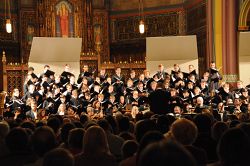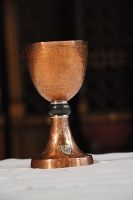Bishop Scanlan commemorated
Friday, May. 15, 2015

Intermountain Catholic
Photo 1 of 2
The Choristers of The Madeleine Choir School and the Choir of the Cathedral of the Madeleine present Charles Gounod's Messe solennelle de Sainte-Cécile during the May 10 performance of the Madeleine Festival Concert, the last of the season. The concert commemorated the centennial anniversary of the death of the Right Rev. Lawrence Scanlan, first Bishop of Salt Lake City. IC photo/Marie Mischel
SALT LAKE CITY — On May 10, the Cathedral of the Madeleine marked the 100th anniversary of the death of the Right Rev. Lawrence Scanlan, first Bishop of Salt Lake City, with a memorial Mass.
Bishop Scanlan is interred at the north end of the cathedral, which was constructed during his tenure, noted Monsignor M. Francis Mannion in his homily at the memorial Mass.
Msgr. Mannion, who is now retired, oversaw the interior renovation of the Cathedral of the Madeleine in 1994.
Following is an excerpt from his homily:
Bishop Scanlan was as far removed as could be from the prince-bishops of Europe. He was a man of enormous simplicity and humility. More than one commentator has pointed out that Bishop Scanlan was not concerned about leaving behind a record of himself. He was not concerned about his posterity and the glorification of his achievements.
What we do know is that Lawrence Scanlan buried himself in the difficult task of being a pastor for his people in the rugged and far-flung communities of the Territory of Utah, as it was then known.
No task was too menial for him. Often in springtime, he could be seen driving a horse and plough in the fields around Holy Cross Hospital to provide food for the patients and staff. This was a skill he no doubt learned from his young days on his father’s farm in County Tipperary in Ireland.
Everything we know about the ministry of Bishop Scanlan, and the few priests, sisters, and laity who assisted him, tell us how rough and unbelievably challenging were his early years in Utah. Pastoral work was difficult and exhausting in the years before and after Lawrence Scanlan became the Bishop of Salt Lake City.
The harsh and often discouraging conditions of the mission in Utah were recorded in one of the few descriptions Bishop Scanlan left behind. He wrote: “We have to travel day and night in cold and comfortless stages over rough roads – roads sometimes almost impassible because of snow.”
The difficult challenges of founding the Church in Utah – in a rough and comfortless desert – often led to discouragement, and often seemed to come to nothing.
Thus, Archbishop Alemany of San Francisco could report to the Vatican in 1878 that, “The actual condition of the mission of the Territory of Utah is still very sad and humanly does not announce much progress in the near future.”
Yet Bishop Scanlan was able against all odds to found parishes like St. Mary’s in Park City and St. Joseph’s in Ogden. He opened hospitals, schools and orphanages. He was successful in bringing many religious sisters to Utah, the spiritual descendants of whom still work in this diocese today. He attracted priests to assist him in ministering to the far-flung regions of Utah.
The geographical scope of the fledgling diocese was mind-boggling. It included nearly 160,000 square miles, which included all of Utah and the eastern counties of Nevada, making it the largest diocese in the United States at the time. One can only imagine the challenge of providing ministry in that expansive territory.
Bishop Scanlan was able to live this arduous life because of his legendary stamina, determination and drive. Later in life, he developed mountain fever, which curtailed his nearly impossible schedule.
On one occasion he was thrown from his horse while visiting a mission in Nevada and was never the same thereafter. His later years were ones of physical and mental decline, yet what he achieved lives on down through the decades since then.
While the social history of the Church in Utah is in great part lost, what remains visible in Bishop Scanlan’s greatest material achievement: the Cathedral of the Madeleine.
This cathedral dramatically portrays the angels and saints of the Old and New Testaments. But there are many faces missing from the mural. Missing are the faces of the anonymous men and women who built up the Church in Utah. Bishop Scanlan’s face is not there. Neither are ours.
But in that is a challenge: that we may be inscribed one day on the heart of God.
By God’s grace, Bishop Scanlan and our spiritual ancestors in this diocese are now in the Kingdom of God, giving eternal praise and glory to the Holy Trinity. We look forward to the day when we can visit with them and learn the full story of the foundation of this diocesan Church.
The faith of these heroic and unassuming people, our ancestors in the faith, lives on in us today. We are indebted to them. It was their faith and their sacrifices that gave us this impressive cathedral, as well as our churches, schools, and orphanages.
Our ancestors in the faith in Utah were truly a pilgrim people. The faith of these poor and unassuming people lives on in us today. We are indebted to them. It was their faith that formed the foundation of the great heritage passed on to us today.
Fr. Martin Diaz, rector of the Cathedral, commissioned a special chalice for this anniversary. The chalice commemorates not only Bishop Scanlan’s ministry, but also the heroic Catholics who were so grateful when he came to visit them and celebrate with them the Mass and the sacraments.
This chalice, crafted by local artists, is made of silver, gold and steel, and honors the miners who, in the beginning, were Bishop’s Scanlan’s principal parishioners. By this chalice we will not only receive the blood of Christ; we will also be in communion with all the angels and saints; and not least we will be at one with Utah’s first bishop.
May we be faithful heirs to the pioneers of the early Utah Church and be as committed to the difficulties of ministry as was our first bishop; and may Lawrence Scanlan now enjoy eternal rest, the beauty of God, and everlasting Easter joy.
For questions, comments or to report inaccuracies on the website, please CLICK HERE.
© Copyright 2024 The Diocese of Salt Lake City. All rights reserved.
© Copyright 2024 The Diocese of Salt Lake City. All rights reserved.


Stay Connected With Us